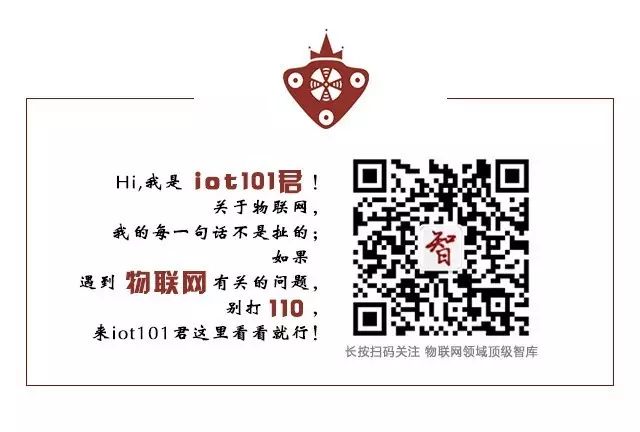
Author: iot101
IoT Think Tank Original
Please indicate the source and origin when reprinting
—— [Introduction] ——
How should we explain what a “communication module” is to a beginner who has just entered the field of IoT? What key role does the communication module play in the IoT industry chain?

This is the 3rd article in the “IoT Beginner Series”
Special thanks to Mr. Yang Yueqi from Youfang Technology for his assistance during the writing process
Anyone with a basic understanding of IoT concepts will not be unfamiliar with the term “communication module”. Whether in industry news, in-depth articles, or industry reports, this term frequently appears, including cellular communication modules, Wi-Fi modules, LTE modules, NB-IoT modules, LoRa modules, and so on… The variety is endless.
So, the question arises: how should we explain what a “communication module” is to a beginner in the IoT field? What key role does the communication module play in the IoT industry chain?
Note
A module is a broad concept. A software module refers to a collection of program statements that can be independently named and complete certain functions (i.e., a collection of program code and data structures); a hardware module refers to a complete functional system composed of multiple components with basic functions.
Anything that meets the definition can be called a module, which can be categorized into communication modules, positioning modules, light-sensing modules, etc…
Since most modules mentioned in the IoT field refer to wireless communication modules, this article will only provide a brief introduction to the knowledge of wireless communication modules. Additionally, in Taiwan, modules are often referred to as “modules”, which means the same thing.
Let’s start with a very basic question: If you want to communicate with a loved one far away, what should you do?
I believe that unless you have traveled from the Stone Age, you would naturally answer: make a phone call!
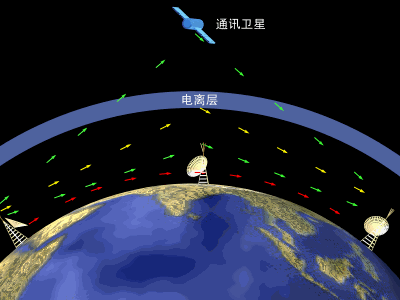
Thanks to the property of electromagnetic wave signals that can freely propagate through space, we can transmit sounds, text, data, images, and other information over long distances without cables.
However, we do not have special abilities; we cannot send electromagnetic waves directly through our bodies, nor can we understand the information contained in electromagnetic wave signals.
At this point, we need a device like a mobile phone to help us receive and send electromagnetic wave signals and convert them into information we can directly understand.
It is precisely because of the existence of mobile phones that we users do not need to understand how electromagnetic waves are sent and received; all we need to do is dial and talk, it’s that simple and convenient~

Similarly, in the IoT era, if devices want to communicate with each other, what should they do?
That’s right, they also need a device similar to a “mobile phone” to help them send and receive signals, and this is what we call a wireless communication module.It is a collection composed of chips and the peripheral circuits required by the chips, and there is currently no unified definition in the industry.
The wireless communication module enables various IoT terminal devices to have the capability of network information transmission, serving as the information entry point for various smart terminals to connect to the IoT.
It is a key link connecting the perception layer and the network layer of the IoT. All device data generated by the IoT perception layer terminals needs to be aggregated to the network layer through the wireless communication module, which is then managed remotely through a cloud management platform, while data analysis improves management efficiency.
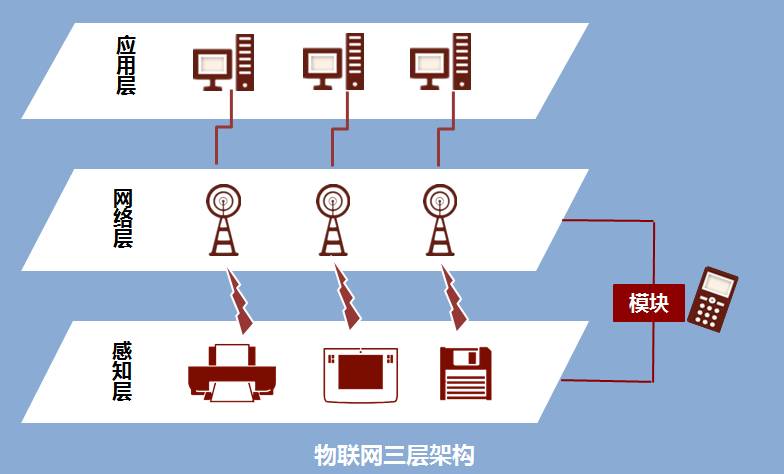
We know that the IoT is a long industrial chain, with chips upstream and terminal applications downstream… So, where does the value of the module lie?
Let’s borrow the example of communication between people using mobile phones mentioned earlier.
Imagine if you were only given a chip, could you use it to make a phone call?
The answer is definitely no.
It requires manufacturers from both upstream and downstream of the industrial chain to assemble the chip with other components, add a screen and casing, and create a complete mobile phone. Only then, after inserting a SIM card, can you use it to make calls.
Similarly, if a device wants to “call” another device, simply giving it a component (for example, embedding a baseband chip in the device) will not work.
At this point, it requires module manufacturers to integrate various components such as baseband chips, RF, memory chips, capacitors, resistors, etc., and assemble them into a “mobile phone” that the device can directly use, allowing it to “call” after inserting a card.
So this is the first layer of value of modules in the IoT industry chain: hardware integration and software design, integrating multiple communication standards to meet environmental requirements in different application scenarios, greatly simplifying the work of application manufacturers.
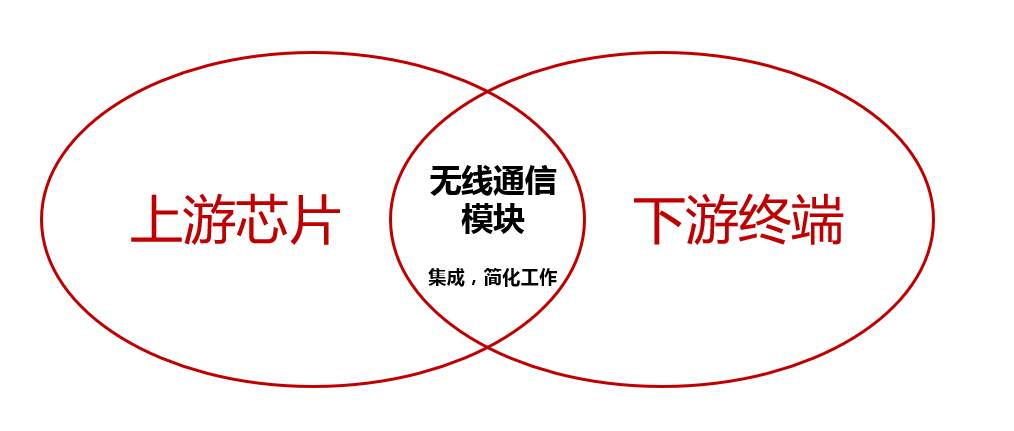
Just as mobile phone users do not need to understand the principles of radio communication and can use their phones easily, application manufacturers also do not need to carry out complex integration work themselves; they can buy products from module manufacturers and use them directly.
Note: Not all companies need to purchase modules from module manufacturers when making IoT devices; companies can integrate them according to their needs, but this is akin to building a mobile phone from scratch, which requires a lot of manpower and resources.
That said, there are significant differences between communication between devices and communication between people. Simply put, the communication needs of devices are more complex~
Why do I say this?
It turns out that whether you are yellow, white, or black; whether you are from Beijing, Shanghai, or Fujian, the communication needs are relatively consistent—being able to send short messages, images, videos over long distances and conduct voice calls.

However, the communication needs between devices vary greatly.
If it is a water meter, it only needs to transmit a small amount of data and does not need to transmit every day; if it is a car, the amount of data it needs to transmit is much larger, and the real-time requirement for data is very high; other devices—such as motors in factories, streetlights, and home speakers—each have their own communication needs…
There’s no helping it; fragmentation is a characteristic that the IoT was born with.
So, this is the second layer of value of modules in the IoT industry chain: the upstream of wireless communication modules is baseband chips and other production materials, which have a high degree of standardization; the downstream consists of various segmented application fields, which are extremely dispersed. The IoT module itself is in the middle link between standardized upstream chips and dispersed downstream vertical fields, needing to meet the specific needs of different customers and application scenarios.
Generally speaking, 2G modules are widely used in scenarios with low data requirements, such as early shared bicycles (of course, shared bicycles are now beginning to try LPWAN technology); 3G modules are used in mobile payment fields with higher data requirements; 4G modules are used in fields requiring higher speeds, such as automotive and video surveillance; while LPWAN modules were first commercially used in meter reading fields with high power-saving requirements.
Summary of Module Value
First Layer of Value: Hardware integration and software design, integrating multiple communication standards to meet environmental requirements in different application scenarios, greatly simplifying the work of application manufacturers.
Second Layer of Value: Positioned in the middle link between standardized upstream chips and dispersed downstream vertical fields, needing to meet the specific needs of different customers and application scenarios.
Module manufacturers’ profit model involves procuring upstream materials, designing and selling products, and production can be done in-house or outsourced to third-party processing plants. Manufacturers can customize development according to the requirements of application manufacturers for different application scenarios. No matter how challenging the device is, they strive to satisfy it~
Wireless communication modules can generally be classified according to different communication technologies as follows:
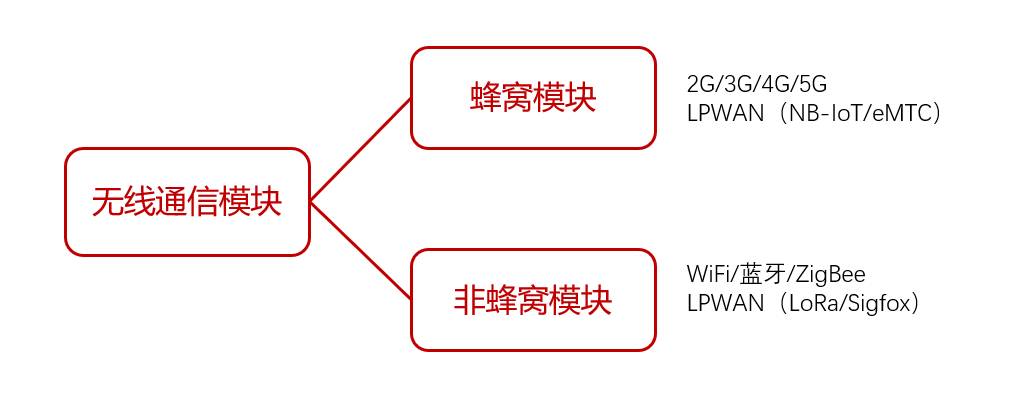
A 2G module refers to a module that can access the operator’s 2G network, while an NB-IoT module refers to a module that can access the NB-IoT network, and so on.
Because the IoT involves the networking of devices across various industries, encompassing a wide range of application scenarios, different application scenarios require different wireless communication modules, making the application scenarios of modules particularly rich and the market space very large.
In the IoT application scenarios, the major fields that have formed a large market (with annual demand exceeding 10 million) include smart metering, mobile payment, smart automotive, and smart grid. The growth in these fields has driven the main growth of the wireless communication module market.
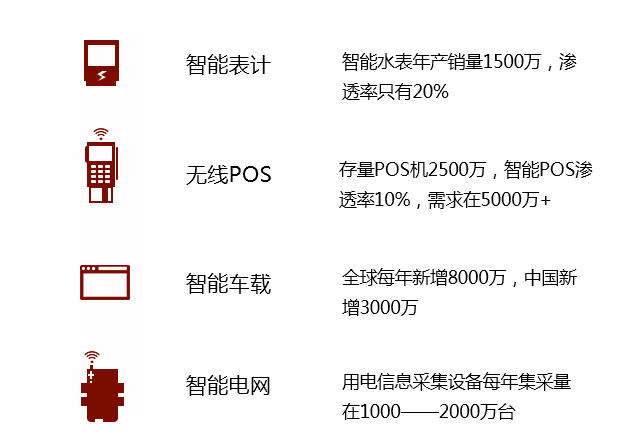
Source: Guosen Securities “Research and Thoughts on the Wireless Communication Module Industry”
Currently, some well-known manufacturers in the wireless communication module field, both domestically and internationally (only a few are listed), include:
| Region | Manufacturer | Description |
| International | Sierra Wireless | Sierra Wireless was established in 1993 and is the world’s first supplier of cellular communication modules, with a full product line including 2G, 3G, 4G, LPWA modules, Bluetooth, WiFi, GNSS, etc. The module business has become the undisputed industry leader. |
| u-blox | Most companies are developing and selling chips and modules for wireless communication and positioning, so u-blox is committed to achieving this in an excellent manner and focuses on customers and their applications, investing heavily in R&D to provide IoT products and solutions needed by everyone. | |
| Telit | Headquartered in Italy, Telit is a global leader in M2M wireless communication products and solutions, with its wireless communication module products widely used in tracking, industrial automation, security, and remote sensing markets. Telit offers products in three technologies for M2M applications: 1. Long-distance wireless communication including LTE, WCDMA, CDMA, GPRS, EVDO, etc.; 2. Short-range wireless communication modules such as Zigbee; 3. Global navigation positioning technology, supporting GPS, GLONASS, and other global satellite navigation systems. | |
| Gemalto | Gemalto was formed in June 2006 by the merger of the world’s two largest smart card manufacturers, Axalto and Gemplus, and is a global leader in digital security, expanding its Cinterion® machine-to-machine (M2M) solutions portfolio to include M2M-grade LTE wireless modules. | |
| Domestic | Youfang (Neoway) | Youfang Technology focuses on exploring and realizing wireless application needs, providing professional industrial modules for various communication standards such as 2G/3G/4G/LPWA/GNSS/short-range wireless, as well as industrial IoT solutions and automotive-grade communication modules, with a complete R&D and design system including product planning, industrial design, structure, hardware, software, testing, and logistics, aiming to become the most respected wireless product and service provider globally. |
| SIMCom | SIMCom is a leading provider of M2M modules and solutions globally. Since its establishment in 2002, it has been committed to providing various technology platforms for GSM/GPRS/EDGE, WCDMA/HSPA/HSPA+, CDMA 1xRTT/EV-DO, FDD/TDD-LTE, eMTC (CAT-M1), NB-IoT wireless cellular communication, as well as GPS/GLONASS/BEIDOU satellite positioning. According to the latest M2M report from the well-known market research company ABI Research Inc., SIMCom’s wireless communication module shipments ranked first globally again in 2016. | |
| YeeLink | YeeLink was established in 2010 and is a leading supplier of GSM/GPRS, UMTS/HSPA/(+), LTE, and GNSS modules, with its products achieving significant success in the domestic smart POS market, overseas automotive OEM market, and operator market. It is a leader in the NB-IoT module field and was one of the early partners for Huawei’s NB-IoT chip production. YeeLink was listed on the New Third Board and is currently planning to list on the A-share market, having submitted relevant materials to the Shanghai Regulatory Bureau. | |
| LongShang | LongShang Technology is a global leader in information and communication solutions, providing a full range of wireless communication modules including GSM/GPRS/EDGE, WCDMA, CDMA1X/EVDO, TD-SCDMA, and LTE, as well as IoT application solutions based on wireless communication modules. | |
| Fibocom | Fibocom is the first listed provider of wireless communication modules and solutions in China. Its products cover LTE, NB-IoT/eMTC, HSPA+, GSM/GPRS wireless communication modules and solutions, with major shareholders including Intel, the world’s largest personal computer parts and CPU manufacturer. | |
| GaoXinxing IoT | GaoXinxing is a provider of IoT applications and services for smart cities. In 2016, it acquired ZTE’s wireless communication module subsidiary, ZTE IoT. ZTE IoT focuses on the enterprise market and has a strong foundation in automotive and satellite communication applications. |
The IoT Think Tank has specially established the “IoT Beginner” column to popularize seemingly complex and difficult-to-understand technological concepts.
If you have any content you would like to see, please feel free to leave a message in the comment area!

Previous popular science articles (click on the article title to read directly):
-
“How Difficult is it to Make Smart Locks for Shared Bicycles?”
-
“Explaining IPv6, which is valued by both the Central Office and the State Office, in simple terms”
-
“What is the blockchain technology that is disrupting banks and the IoT, attracting the attention of Siemens and Alibaba?”
-
“Explaining CPU/GPU/TPU/NPU…XPU in simple terms”
-
“A cartoon explaining: Besides WiFi and Bluetooth, what can the recently popular NB-IoT do?”
-
“A cartoon explaining: What is LoRa, which everyone is talking about behind NB-IoT?”
